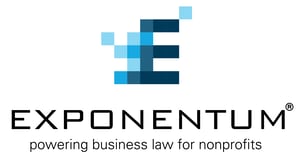


PUBLISHED 3/20/2020
Exponentum®, in partnership with the law firm of Orrick, Herrington, and Sutcliffe LLP, has prepared the following article to help guide nonprofit employers responding to COVID-19. Michigan Community Resources is proud to be a member of Exponentum, a national network of business law pro bono providers.
In the afternoon on March 18, the Senate passed the House’s Families First Coronavirus Response Act (FFCRA) and President Trump signed the bill into law. Below are answers to some frequently asked questions about provisions of the FFCRA that are of particular importance to employers: the emergency expansion of the Family and Medical Leave Act (FMLA) and emergency paid sick leave.
When does the FFCRA apply?
The FFCRA applies in the event of a “public health emergency.” “Public health emergency” is defined as “an emergency with respect to coronavirus declared by a Federal, State, or local authority.” Because the President declared a national emergency on Friday March 13, we are already in a public health emergency.
Who do these provisions apply to?
Employers with fewer than 500 employees and government employers. However, the Secretary of Labor can exempt small businesses (fewer than 50 employees) if the required leave would “jeopardize the viability of their business.” The FFCRA also excludes employers with fewer than 50 employees in a 75-mile radius from civil FMLA damages in an employee-initiated lawsuit. Employers can also decline to provide leave to healthcare providers and emergency responders.
When does the FFCRA go into effect?
The FFCRA takes effect no later than 15 days after its enactment or April 2, 2020. It is currently set to stay in place until December 31, 2020.
EMERGENCY FMLA EXPANSION
How much leave are employees entitled to under the FFCRA’s expansion of FMLA?
Employees who have been employed for 30 days or more are entitled to up to 12 weeks of job-protected FMLA leave for a “qualifying need.”
What is a “qualifying need”?
A qualifying need is limited to instances in which an employee is unable to work or telework because his or her child’s school, day care, or child care is unavailable. Note: it does not apply to when an employee is experiencing symptoms, in quarantine, or caring for a family member with symptoms or in quarantine.
Is the leave paid?
The first 10 days may be unpaid and employees may elect to use other paid benefits to cover that time period. After the first 10 days, the leave must be paid at no less than two-thirds of the employee’s regular rate of pay. However, the required pay is capped at $200 per day and $10,000 in total.
EMERGENCY PAID SICK LEAVE
What does the FFCRA require?
It requires employers to provide emergency paid sick leave in addition to what the employer already provides in certain circumstances.
Who does it apply to?
It applies to all employees, regardless of the amount of time the employee has been employed by the employer.
In what circumstances can an employee take sick leave under the FFCRA?
Sick leave under the FFCRA can be used: (1) if employee is experiencing symptoms of coronavirus or is quarantined; (2) to care for a family member experiencing symptoms or who is quarantined; (3) to provide child care; or (4) if the employee is experiencing substantially similar symptoms as specified by the Secretary of Health and Human Services.
Employers may not require or request documentation or certification from a doctor.
How much leave do employees get?
Full-time employees are entitled to up to 80 hours of paid sick leave during the effective period of the Act. Part-time or hourly employees are entitled to the number of hours the employee was scheduled to work for 2 weeks, or the number of hours the employee regularly works in a typical two-week period.
At what rate of pay must the sick leave be paid?
Sick leave for employees who quarantine or seek diagnosis or medical care must be paid at the employee’s regular rate of pay. Sick leave to care for a family member or a child due to school closure must be paid at two-thirds the employee’s regular rate of pay.
However, the pay is capped at $511 per day and $5,110 in the aggregate for leaves where the employee is in quarantine, self-quarantine, or experiencing symptoms of coronavirus and seeking a medical diagnosis. Paid sick leave is capped at $200 per day and $2,000 in the aggregate if the employee is using leave to care for a family member, provide child care, or experiencing any other substantially similar condition to coronavirus as specified by the Secretary of Health and Human Services.
Can employers receive tax credits?
Employers, including nonprofit employers, who are required to provide emergency FMLA or paid sick leave are entitled to receive a refundable tax credit against the employer portion of Social Security taxes. In each calendar quarter, employers may receive a refundable tax credit equal to 100% of the qualified leave wages they are required to pay. Tax credits are capped at the same amounts as emergency FMLA leave and paid sick leave.
Are there similar state laws?
Yes, some states have similar laws. For example, California, Connecticut, New Jersey, New York, Massachusetts and Washington D.C., all have paid sick leave laws that will apply in some circumstances to COVID-19. Local counsel can provide counsel on the interplay of federal and state law.
Visit the State of Michigan’s resource page for more information on employment updates and information in Michigan.
What should nonprofit employers do next?
Nonprofit employers should familiarize themselves with the requirements of this new law and ensure that managers are aware of how to handle emergency FMLA and paid-sick leave requests. The U.S. Department of Labor is to issue further guidance by April 2, 2020 to help employers determine how much paid sick leave their employees can take.
Make sure to clearly document the reason for leave but remember that the employer may not seek physician documentation for emergency paid sick leave.
Remember that privacy laws still apply with respect to communicating the reasons for leaves.
The landscape is changing by the hour so check for the most recent updates. For answers to other Frequently Asked Questions related to COVID-19, please see Orrick’s COVID-19 Resource Center.
Exponentum® is a national network of business law pro bono providers dedicated to improving the quality of life in low-income and disadvantaged communities by expanding the availability and quality of pro bono business legal services for nonprofits that serve those communities. Exponentum partners with law firms and corporations to implement national responses to challenges faced by the nonprofit sector by delivering expert legal assistance and educational programs to nonprofits. For more information about Exponentum, visit www.exponentum.org.
Please note: These resources have been prepared by Michigan Community Resources with assistance from pro bono attorneys throughout Michigan as information only and does not constitute legal advice. This information is not intended to create and receipt of the information does not constitute a client-lawyer relationship.

